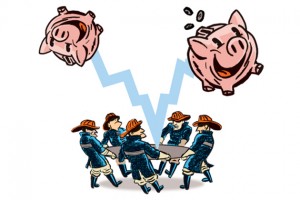 We love to criticize the wastefulness of bureaucracy, the agency ass-covering, and the naiveté of government officials. But it’s a surprising pleasure to read[1] The SIGTARP [2] review of the government’s response to Citigroup’s near-death experience and its bailout in the Fall of 2008.
We love to criticize the wastefulness of bureaucracy, the agency ass-covering, and the naiveté of government officials. But it’s a surprising pleasure to read[1] The SIGTARP [2] review of the government’s response to Citigroup’s near-death experience and its bailout in the Fall of 2008.
Here we have a US Treasury position created for the purpose of reviewing the government’s own actions in the heat of the crisis, and we might be excused for bringing low expectations to the table. I have to admit, however, that my jaundiced eye opens wide with the quality of the analysis and indeed the downright feistiness of the SIGTARP report.
The report reviews the timeline of the crisis, the systemic need to bail out Citigroup, and the particulars of negotiating – actually, Treasury mandated – a $20 Billion preferred-equity capital infusion and a loss-absorbing backstop for a $300 Billion ring-fence around Citigroup’s riskier assets.
We do not know what would have happened without government intervention on behalf of Citigroup, but the SIGTARP nicely summarizes the case for Citigroup’s status as a Too Big To Fail (TBTF) Bank for those of us with short memories. Citigroup was at the time the largest currency exchange bank, the largest consumer finance lender, the world’s largest credit card lender, the 2nd largest banking organization, the third largest mortgage servicer, and the fourth largest student lender, with over $175 Billion in uninsured domestic deposits.
SIGTARP shares numerous interesting details from the negotiations in October and November 2008.
First, the government needed to lie to itself and the public in the Fall of 2008 when it declared Citigroup a ‘healthy and viable’ banking institution[3], as a necessary condition for providing an initial $25 Billion capital infusion through the Capital Purchase Program (CPP) in October 2008.[4] Treasury Secretary Paulson and New York Federal Reserve Board (FRB) President Geithner clearly felt at the time that they could only get Congressional support for the CPP if it came with a large dose of self-deception about ‘healthy and viable’ banking institutions. Why would a ‘healthy and viable’ banking institution need an emergency $25 Billion capital infusion from the government anyway? It’s a Potemkin Village type absurdity, and SIGTARP lets us enjoy the irony.
Next, Treasury, FDIC, and the FRB cut a pretty good deal for taxpayers in negotiating with Citigroup. Most importantly, they announced to the public (and Wall Street) the ‘ring-fencing’ of over $300 Billion in Citigroup assets – government insurance against losses. By ring-fencing, they separated presumably toxic assets on Citigroup’s balance sheet, and declared these assets would be treated in a special way to limit Citigroup’s total losses.
Here’s the clever part about the ring-fence; Citigroup remaining on the hook for the first $39 Billion in losses, with a combination of Treasury and FDIC absorbing the majority of the next $15 Billion in losses, and the Federal Reserve Board absorbing the rest of the loss risk via non-recourse financing. While the announcement emphasized the government insurance for Citigroup’s riskiest CDOs, RMBS, CMBS, and auto loan ABS, loss-scenarios suggested only Citigroup would bear the losses on the portfolio.[5]
If you can’t figure, as neither Citigroup nor the market could out at the time, what the bank’s biggest loss could be on its portfolio, then the market would assume the worst and treat Citigroup as a soon-to-fail entity going the way of Bear Stearns, Lehman, and AIG. But if you can precisely define, as the ring-fence did, the upper limit of the bank’s losses, then the market understands the known limit and the self-fulfilling prophesy of expected losses leading to financial wipeout can stop. So, that’s clever.
Following this announcement, as intended, markets credibly believed Citigroup to be TBTF, with a perceived government guarantee on a huge portion of its riskiest assets. The stock-shorting activity reversed, CDS spreads tightened, and we saw no world-wide run on Citigroup’s bank deposits.
SIGTARP’s feistiness surfaces most particularly in reviewing not only the actions of government leaders, but their disagreements with each other and with its review. Numerous times throughout the report, we learn of requests by FDIC’s Sheila Bair to change or redact statements in the report. We also learn that Citigroup successfully withheld a listing of its ring-fenced assets from publication by SIGTARP, citing propriety information[6], but SIGTARP is not afraid to respectfully disagree.
SIGTARP’s summary of the story emphasizes the ad hoc, but ultimately correct, decision of government leaders to massively intervene on behalf of Citigroup. SIGTARP calls out our own government for what they failed to make Citigroup do; this distinguishes the report and makes for good reading.
SIGTARP gets to the heart of unsolved problems with the government interventions of 2008. Citigroup, along with more than a dozen financial institutions, today remains TBTF. Which means we could repeat the same crisis we all just survived.
Not only that, but SIGTARP rightly states that the last bailout may increase the likelihood and severity of the next crisis, because the moral hazard problem also remains with us today. High-risk takers, namely Citigroup creditors and counterparts, were not punished in the bailout, so they may reasonably expect to under-price similar credit and counterpart risk in the future, believing that the government provides an invisible safety net underneath high-wire risk taking.
Even short of a repeat crisis, we know that the implied government guarantee for TBTF institutions constitutes a massive subsidy to Citigroup and its brethren via lowered borrowing costs and collateral costs. This subsidy provides huge advantages over smaller financial firms, but, more troublingly sets the taxpayer up for unlimited liability for private institutions, with little discernible public benefit. Citigroup, the big red umbrella, is still not paying us citizens for the giant insurance policy we offer them.
I don’t criticize the government, and neither does the SIGTARP, for preventing a Citigroup collapse in the Fall of 2008. I do blame the US government, and thankfully SIGTARP does too, for allowing TBTF banks to continue their invisible but nevertheless powerful draw on free taxpayer support.
Ultimately, as SIGTARP rightly (and depressingly) points out, we cannot know the cost of this Citigroup bailout until we know the cost of the next bailout, partly born out of this one.
Two concluding thoughts make me optimistic, however.
First, although SIGTARP is part of the government, it plays the ombudsman role fairly, critically analyzing what other parts of the government have, and have not, done since the acute crisis subsided. There’s hope in a system which can criticize itself and thus correct its future course. Course change is hard, but a report like SIGTARP’s makes it possible. I made this thematic point in an earlier post, but it’s worth emphasizing. I’m not sure we’re improving, but I am sure that critical thinkers within the system, like SIGTARP, give us a chance at improvement.
Second, throughout the narrative of Citigroup’s near collapse and rescue, we see instances of massive government intervention but not a massive government power grab. This too bears remembering. The United States has a tradition of public official respect for private enterprise, which is both understood and credible – but not always recognized by politicians wanting to score points. [7]
A market collapse and an overwhelming government bailout naturally give rise to conspiracy theories on the political fringes. Many, if not most, societies in the rest of the world would fit the Citigroup events into a conspiratorial, but ultimately unhelpful narrative. The specific history of Citigroup as told to us by the SIGTARP, however, reminds us that even if the government did not get everything right, they actually did pretty well, considering.
Please also see SIGTARP Part I – Truth in Government
SIGTARP Part II – Biggest Banks Still Too Big To Fail
SIGTARP Part IV – Which Small Banks are Going Under Next?
and SIGTARP Part V – The AIG Bailout
[1] Assuming you like wonkish reviews of the government’s response to the 2008 Credit Crunch as much as I do.
[2] Special Inspector General for the Troubled Asset Relief Program, aka SIGTARP, aka Norse God of Financial Accountability.
[3] Both Treasury Secretary Hank Paulson and FDIC Chair Sheila Bair used this description in written and spoken statements.
[4]A banking institution had to be “healthy and viable” to be considered a “Qualifying Financial Institution,” as only “Qualifying Financial Institutions” could receive this capital infusion.
[5] As, in the end, it turned out. When the $300B guarantee program unwound in the Fall of 2009, only Citigroup had suffered losses. So we’ve got that going for us. Which is nice.
[6] In pointing this out we get to share SIGTARP’s undoubted chuckle about the ‘special sauce’ of proprietary information Citigroup keeps from its competitors, which contributed to one of the most catastrophic losses in human financial history. Seriously, guys? No one wants your special recipe of assets that contribute to financial Armageddon for your bank.
[7] Anti-market and anti-government cranks both see vast conspiracies and vindication of their own warped views in the events of 2008, but thankfully they mostly troll the Internet commentary pages and do not reflect, you know, reality.
Post read (8992) times.

